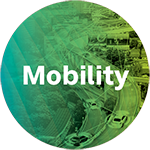Using data for smart mobility concepts
The mobility revolution poses major challenges for municipalities. Growing cities with expanding peripheries require different mobility concepts than rural regions with declining populations. Smart City supports the needs of commuters, users of public transport, pedestrians or car and bicycle users. It also achieves sustainability and accessibility in both moving and stationary traffic. In minimize the costs of road congestion, which today account for around 1% of GDP across Europe, intelligently networked urban mobility and innovative drive concepts are needed. The Internet of Things (IoT), sensors and data collected and processed by artificial intelligence (AI) will increasingly support municipalities in implementing smart health goals in the future.
Do you have any questions?

Werner Achtert
Head of Public Sector
+49 69 580045 1222
werner.achtert@msg.group
How the environment can benefit from smart mobility concepts
Roughly 18 percent of the global emission of CO2 are due to the combustion of fuels in road traffic. Electric vehicles need a broad, user-friendly network of charging stations, e.g., integrated in smart lampposts. Sustainable solutions are also offered by Mobility as a Service (MaaS), where the desired itinerary is connected in real time with local offers of mobility providers on a platform. This allows travelers to plan, book and pay for their journeys. Depending on their needs, they easily switch between car, bicycle, electric scooter or public transport. Traffic management services based on artificial intelligence already regulate the change of traffic light phases depending on the traffic volume in a model-like manner. This reduces CO2 emissions in urban environments and makes living spaces climate-neutral.
How road safety can be improved in road traffic through smart mobility concepts
As the population in urban areas grows, so does the volume of traffic. This is accompanied by exhaust pollution that is hazardous to health, a growing number of traffic fatalities and additional barriers for people with limited mobility. Smart lane markings equalize traffic volumes at peak times. They automatically adjust to the current traffic situation and thus increase the safety, especially for cyclists and pedestrians. Sensor-equipped e-vehicles used by waste management or other service providers not only reduce CO2 emissions. At the same time, they enable the detection of road damage to ensure prompt repair and minimize the risk of injury.
How living together in the community can be optimized through smart mobility concepts
Travelers need a high degree of flexibility in terms of public transport availability and frequency in order to reach their destination quickly and reliably. Costs and accessibility are ideally designed in such a way that everyone can participate in social life. To this end, smart passenger information systems analyze data from GSM and GPRS in vehicles, electronic displays at stops and scheduling software to record load factors and possible delays. By networking and making this data available, commuters get the best possible connecting train. Mobility providers can use this data to assess the current traffic levels and to increase capacity, for example. GPS data in real time, provided by smartphones and vehicles, helps to better coordinate visitor flows at events.
Our solution is called koda.city
For all these innovations, data is collected in real time in the smart city, analyzed and processed with AI. In general, this data must not serve an end in itself, but exclusively for the common good. This needs a public-welfare oriented data ecosystem. Based on open interface standards, our municipal data platform koda.city provides support as a unified, secure and sovereign data space.




